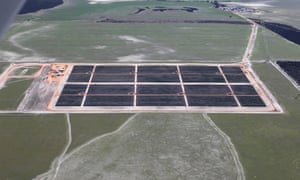Extract from The Guardian
Hareon Solar executive says firm is considering a
billion dollar investment in large scale solar within a year but
policy stability, not subsidies, is needed
Rows of solar panels face skywards at the
Greenough River Solar project near the town of Walkaway, about 350 km
north of Perth. A Chinese firm says further investment in solar in
Australia is being held back by policy uncertainty. Photograph:
PR/Reuters
Lenore
Taylor in Paris
Saturday 5 December 2015 10.38 AEDT
Chinese firm Hareon Solar is “actively”
considering a billion dollar investment in large scale solar projects
in Australia, but the stability of government climate policy is its
major concern, a senior company executive has told Guardian
Australia.
Jie Zhang, Hareon’s vice president of global
business development said government subsidies were not necessary for
the investment decision, to be taken within a year, but policy
stability was required.
“Our only wish for government is a stable
policy, don’t flip back and forth, of course we are concerned what
has happened in the past in Australia with the renewable energy
target,” he said in an interview at the Paris climate summit.
“Stability of policy is the number one thing
that we look for. We made a very sad investment in Bulgaria, we
responded to a call from government together with other companies and
then they changed their policies. Solar is a 25 year investment. If a
government can’t keep its policy stable for five years how can we
inves,” he said.
Hareon solar is a major Chinese solar cell
manufacturer and global investor in large scale solar projects,
founded by Australian citizen Samuel Yang.
It has invested in solar projects delivering 700
megawatts of power in China
as well as big projects in Bulgaria, Romania and the United Kingdom
and smaller projects in the US and Japan.
Zhang said investment decisions were driven by
government subsidies, but now required strong demand and policy
stability.
Australia’s east coast electricity market is
oversupplied, but Zhang insists large scale solar could be
competitive at peak supply times.
“If you really had oversupply, your electricity
price should be dirt cheap, but I don’t see that, your prices are
high.
“ Oversupply can mean two things, it can mean
over-supplying at the wrong time ... our cost per kilowatt hour
during peak times will be lower than coal at peak hours,” he said.
“We are very interested in investing in
Australia, we are actively looking at this market and the generation
and distribution in each state. We could install between 1 and 2
gigawatts of solar in Australia in the near future.”
“We will make a decision within a year. The
market has matured for this investment, the cost of solar has come
down and the electricity price in Australia remains high – so even
without a proactive government strategy it is good to invest – of
course we like government incentives, but we do not depend on them.”
The Australian Renewable Energy Agency has
announced a large-scale
solar competitive round, seeking bids from major solar PV project
proponents for grants of up to $30 million from a $100mn program. The
Clean Energy Finance Corporation has announced a complementary $250
million large-scale solar financing program.
Renewable
energy investment in Australia froze in the early years of the
Abbott government when the renewable energy target was under review.
In the end in was wound back, but not abolished.

No comments:
Post a Comment